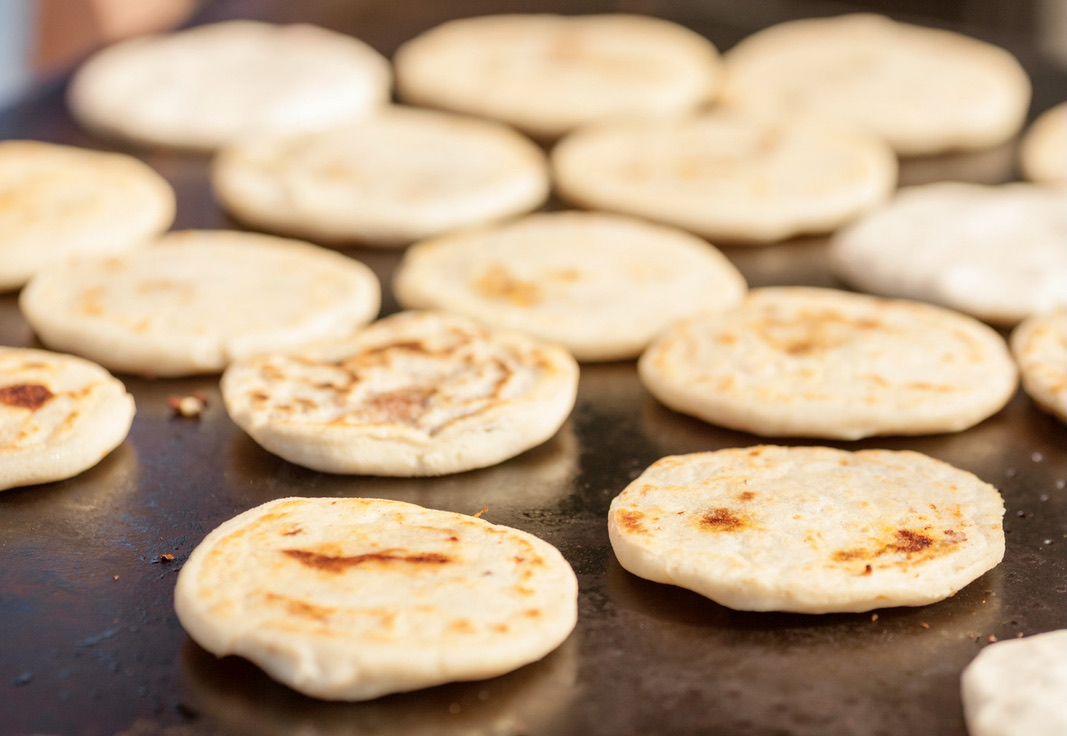
Una Pupusa Mas, Please
by Raquel Mentor
When I was a kid, my Mami used to sell pupusas out of our kitchen. Her pupusas had a cult following. Neighbors, church members, relatives, and even total strangers flocked to the house and placed large orders, eating some in our kitchen and taking the rest to go.
She perfected the art of preparing the refried beans that were cooked inside the masa. She infused the cheese with her secret ingredient, giving it an extra kick. She dipped her hands in oil, fashioned a perfect circle from the masa, and filled it with just the right amount of cheese and beans. Then she clapped her hands together as she closed in the masa. It sizzled as she placed it on the comal. She knew exactly how long to leave the pupusa for the cheese to flow out and crisp without burning.
The aromas and the sounds that came with her pupusas were simply too much for my siblings and me. With each order my mother filled, we would race down the hall with our plates outstretched and our imploring looks. A successful day for us meant we each ate eight or nine pupusas.
As we grew older, we stopped begging in front of paying customers, and I helped Mami as her cashier and waitress. But I never tried to make pupusas—a skill reserved for my mother—until after I went off to college.
***
When you’re young and in love, you’ll go to great lengths to impress. When the chance to charm a crush presented itself, I knew I had to use my Mami’s special pupusa recipe.
I sheepishly called Mami, not quite letting on about my intentions.
“Mami, ¿Cómo se hacen las pupusas?” How do I make pupusas?
Having an inkling of what was going on, as mothers do, my Mami went over the process thoroughly, including how to make the frijoles a la olla, the masa, and the curtido. She even revealed the secret ingredient for her cheese.
I dashed to the supermarket, eager to win this man over with my cooking prowess.
In my tiny college kitchen, I used a dull knife to clumsily chop inconsistent cabbage shreds, I mangled onions into even weirder shapes. I managed to make a runny cheese concoction, and no matter how much I alternated between water and flour, my masa would not reach the desired consistency. My mami was 2000 miles away, and I refused to follow any internet guidelines.
My crush arrived.
I turned on the comal—pupusas are meant to be eaten freshly cooked, after all—and dipped my hands into the oil and grabbed a small clump of masa. Hearing the familiar sound of my hands clapping as I tried to shape my circle, I knew I was doing something right.
That illusion didn’t last long. The pupusas kept leaking ingredients before I could close in the masa. The process was messy. Trying to keep a cool demeanor, I gingerly drew the misshaped pupusas out of the comal, afraid they’d dissolve before reaching a plate.
I feigned a smile throughout our uncomfortably silent supper. My crush politely ate the food before him, and in solidarity, I ate, too, each mouthful assuring me that I had squandered my chance at love.
My crush and I didn’t end up dating. I highly doubt it was because of the pupusas.
On that day, I ended up thinking a lot less about my crush and a lot more about my Mami. I thought about the long days she spent preparing all the ingredients for the sales. I thought about how she made it look so effortless, yet how exhausting the entire process really was for her. I thought about how our family didn’t have much, but this was her way of being able to provide for us, both in delicious nourishment and in money for things we would ultimately need for the day to day.
And then I thought about how, when my Mami found out I was going to college, she contacted everyone she knew to organize one last huge pupusa sale for me, intending to send me off with enough money to see me through my first month away from home.
I still can’t make a decent pupusa. On those special days when I visit my Mami, I will stretch out my plate with the biggest smile and ask for just one more pupusa con curtido, compliments of the house.
Raquel Mentor is receiving her MA in English from La Sierra University. She is a first-generation college student, who’s parents immigrated from Mexico and El Salvador respectively. While many parts of her culture are lost to her, she feels most connected to her heritage through food, and the stories surrounding it.
